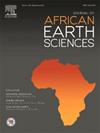尼日利亚尼日尔三角洲沉积带原油生物标志物指纹图谱研究
IF 2.2
4区 地球科学
Q2 GEOSCIENCES, MULTIDISCIPLINARY
引用次数: 0
摘要
对来自尼日尔三角洲盆地4个沉积带的28个原油样品进行了分析,评价了物源输入、沉积环境、热成熟度和代后蚀变。分析方法包括气相色谱法(GC)和气相色谱-质谱法(GC - ms)。齐墩烷/藿烷比值>;0.2,高藿烷指数低,C29 ααα-甾烷占主导地位,C30藿烷含量丰富,表明其贡献来自海相和陆相有机质。C27甾烷的增加表明藻类的输入,而C29甾烷的优势表明植物的贡献显著增加,这是三角洲过渡环境的特征。甾烷异构化比值表明生油发生在早期至峰值油窗内,而藿烷参数则证实了峰值成熟度。生物标志物参数,特别是齐墩烷、甾烷/藿烷和类异戊二烯/正构烷烃比值,描绘了两个油族。A族具有较高的齐墩烷/藿烷值和较低的甾烷/藿烷值,表明主要为氧源、陆源。相比之下,B族包括来自混合来源的油,具有较低的齐墩烷/藿烷和可变的甾烷/藿烷比率。油族分类与成熟度水平无关,因为变化可能反映了烃源岩埋藏史和盆地演化的差异,而不仅仅是热应力的差异。总离子色谱图(tic)和选择离子监测(m/z 191, 217)显示生物标志物组合中没有生物降解,蒸发分离或水洗涤的证据。然而,不能完全排除二次运移或成分混合的微妙影响。这些发现强调了尼日尔三角洲油气生成和聚集的复杂性,这是由不同的有机输入、沉积环境和生烃后地质过程决定的。本文章由计算机程序翻译,如有差异,请以英文原文为准。
Biomarker fingerprinting of crude oils from Niger Delta depobelts, Nigeria
Twenty-eight crude oil samples from four depobelts in the Niger Delta Basin were analyzed to evaluate source input, depositional environment, thermal maturity, and post-generation alteration. Analytical methods included gas chromatography (GC) and gas chromatography–mass spectrometry (GC–MS). Biomarker signatures—oleanane/hopane ratios >0.2, low homohopane indices, dominance of C29 ααα-steranes, and abundant C30 hopanes—indicate contributions from both marine and terrestrial organic matter. Elevated C27 steranes suggest algal input, while the predominance of C29 steranes implies significantly higher plant contributions, characteristic of a deltaic-transitional setting. Sterane isomerization ratios suggest oil generation occurred within the early to peak oil window, while hopane parameters confirm peak maturity. Biomarker parameters, particularly oleanane, sterane/hopane, and isoprenoid/n-alkane ratios, delineate two oil families. Family A exhibits high oleanane/hopane and low sterane/hopane values, pointing to a predominantly oxic, terrigenous source. In contrast, Family B includes oils from mixed sources, with lower oleanane/hopane and variable sterane/hopane ratios. Oil family classification is independent of maturity level, as variations likely reflect differences in source rock burial history and basin evolution rather than thermal stress alone. Total ion chromatograms (TICs) and selected ion monitoring (m/z 191, 217) display no evidence of biodegradation, evaporative fractionation, or water washing in the biomarker assemblage. However, subtle effects of secondary migration or compositional mixing cannot be entirely ruled out. These findings underscore the complexity of hydrocarbon generation and accumulation in the Niger Delta, shaped by variable organic inputs, depositional settings, and post-generative geological processes.
求助全文
通过发布文献求助,成功后即可免费获取论文全文。
去求助
来源期刊

Journal of African Earth Sciences
地学-地球科学综合
CiteScore
4.70
自引率
4.30%
发文量
240
审稿时长
12 months
期刊介绍:
The Journal of African Earth Sciences sees itself as the prime geological journal for all aspects of the Earth Sciences about the African plate. Papers dealing with peripheral areas are welcome if they demonstrate a tight link with Africa.
The Journal publishes high quality, peer-reviewed scientific papers. It is devoted primarily to research papers but short communications relating to new developments of broad interest, reviews and book reviews will also be considered. Papers must have international appeal and should present work of more regional than local significance and dealing with well identified and justified scientific questions. Specialised technical papers, analytical or exploration reports must be avoided. Papers on applied geology should preferably be linked to such core disciplines and must be addressed to a more general geoscientific audience.
 求助内容:
求助内容: 应助结果提醒方式:
应助结果提醒方式:


